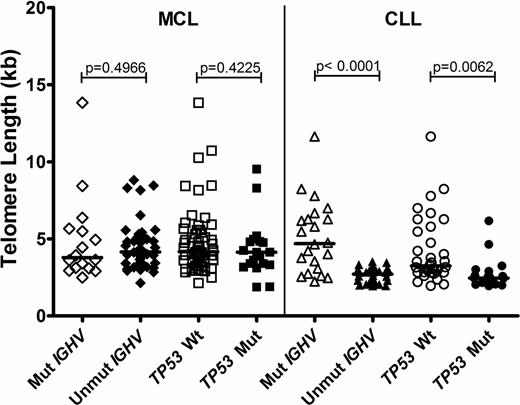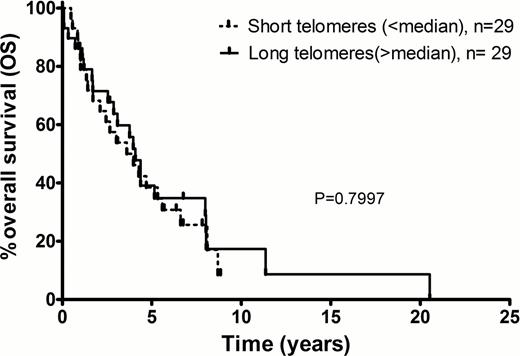Abstract
Abstract 2509
Mantle cell lymphoma (MCL) is a specific subtype of non-Hodgkin lymphoma with a median overall survival of approximately 4–5 years with significant heterogeneity. MCL shows a relatively high number of genomic alterations per case and one of the known causes of genomic instability in somatic cells is telomere dysfunction. Short, dysfunctional telomeres lead to an increase in chromosomal end-to-end fusions which predispose the cells to chromosomal aberrations, genomic complexity and malignant transformation. Here we investigated telomere length in MCL to evaluate associations with biological and clinical disease characteristics as well as outcome. We included a CLL cohort as a control group and for comparison with MCL.
A well characterized cohort of 73 MCL and 55 CLL patients treated at the Universities of Ulm, Würzburg and Heidelberg was used for the study. Telomere length was measured using a Q-PCR-based technique with 25ng of DNA used per reaction in triplicates. Three telomere length controls were included in every plate to control for plate to plate variations. The technique was validated by terminal restriction fragment length (TRF) analysis (R2=0.8516). The TRF value of telomere length for each sample was calculated from the linear regression of Q-PCR vs. TRF. Samples were selected for tumor loads of >70% and were analyzed for correlation with biological and clinical factors.
Telomere length in MCL had no significant association with IGHV (P=0.4966) and TP53(P=0.4225) mutation status which was in marked contrast to CLL where a significant correlation of short telomeres with unmutated IGHV(P<0.0001) and mutant TP53(P=0.0062) was confirmed (Figure 1). Moreover, no significant variations in median telomere length were observed among the MCL subgroups with the different genomic aberrations (del(9p21), del(11q22-q23), del(13q14), del(13qTerminal) and del(17p13)), while in CLL, short telomeres were found to be associated with high risk genomic aberrations del(17p13) (P=0.0001) and del(11q22-q23) (P=0.0037). Since telomere dysfunction is known to confer genomic complexity, we analyzed the correlation of telomere length with the number of genomic aberrations per case. A weak but significant (R2=0.38, P=0.0106) association of telomere shortening with increasing number of genomic aberrations was observed in the younger (age<median) MCL subgroup, whereas no correlation (R2=0.0079, P=0.7516) was observed in the older patient subgroup (age>median). No correlation of telomere length with the proliferation index (Ki67) was observed in the MCL samples, which might be due to variable telomerase activity among the different MCL subsets. Telomere length in MCL also did not correlate with blastoid subtype, age, LDH levels, WBC or with MIPI groups. We studied the impact of telomere length on outcome in MCL and no significant difference in overall survival (median 48 vs. 50 months, p=0.7997) (Figure 2) or progression-free survival (median 26.4 vs. 21.7, p=0.9178) was observed between the long (>median) and short (<median) subgroups. In contrast, when evaluating the impact of established prognostic factors on outcome to verify that our cohort was representative, we observed the expected correlations of Ki67 (p=0.0001), MIPI index (p=0.007) and B symptoms (p=0.0119) with disease outcome.
In conclusion, telomere length in MCL was not associated with any of the established clinical or biological factors relevant for pathogenesis or prognostication and there was no correlation with disease outcome. This is in stark contrast to CLL where telomere length has been significantly associated with biological disease characteristics, pathogenic mechanisms and survival.
Telomere length distribution in MCL and CLL samples with mutated/unmutated IGHV and mutant/wildtype TP53.
Telomere length distribution in MCL and CLL samples with mutated/unmutated IGHV and mutant/wildtype TP53.
Overall survival in the short (<median) and long telomere (>median) subgroups (median 48 vs. 50 months, P=0.7997).
Overall survival in the short (<median) and long telomere (>median) subgroups (median 48 vs. 50 months, P=0.7997).
No relevant conflicts of interest to declare.
Author notes
Asterisk with author names denotes non-ASH members.



This feature is available to Subscribers Only
Sign In or Create an Account Close Modal